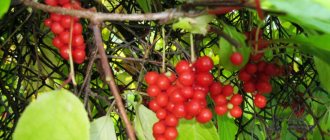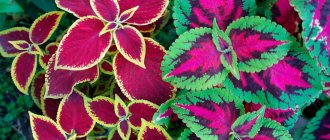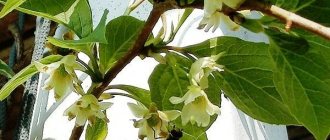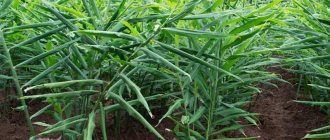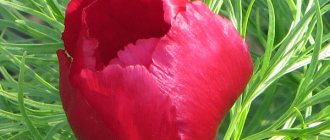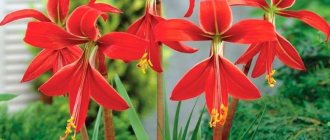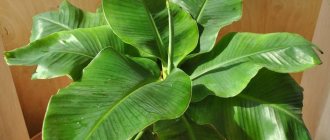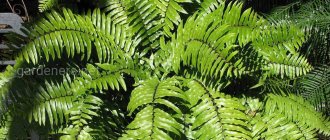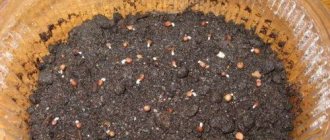Description
The genus Schisandra from the Schisandra family has long been the subject of scientific debate.
Disputes about the number of species included in it lasted more than two centuries. Scientists came to a consensus only in the 21st century, and now the genus includes 25 plant species. Schisandra are evergreen and deciduous vines that, with one exception, grow in eastern Asia at altitudes from 0 to 3000 m above sea level. Only Schisandra glabra liked the southeastern territories of North America. It is noteworthy that it became the type species of the genus and, unfortunately, is now in danger of extinction.
IN THE PHOTO: Smooth lemongrass.
Lianas require support, the role of which goes to neighboring trees, bushes and even rocks. The thin trunk gradually becomes lignified, reaching a height of more than 10 m. The glossy bark of young plants becomes covered with cracks with age.
Petiolate alternate leaves are oval or oblong-lanceolate in outline.
IN THE PHOTO: Leaf blades of Schisandra have a wedge-shaped base, solid or jagged edges, the front surface is bare, the underside is slightly pubescent.
At the end of spring the vines bloom. Within each species there are plants with only female or only male flowers. There are often specimens on which flowers of both sexes are formed. It happens that female flowers appear on a vine one year, and exclusively male flowers the next season.
IN THE PHOTO: Small waxy Schisandra flowers are single or collected in bunches.
After pollination, the receptacle of the female flowers enlarges, and a fruit cluster of bright red berries with one, rarely two, seeds is formed. In cooking, jams and soft drinks are prepared from them, and the bark and leaves are added to tea. The fruits do not fall off for a long time, often remaining on the vine until cold weather arrives and snow falls.
All types of Schisandra have nothing to do with citrus fruits. At the same time, the bark, flowers, and especially the leaves emit a lemon aroma when rubbed. It is because of this feature that the plant received its Russian name.
Popular types
Schisandra chinensis (Schisandra chinensis)
The most common species in culture. The frost-resistant and unpretentious deciduous vine is grown all over the world as a fruit, ornamental and medicinal plant.
IN THE PHOTO: Schisandra chinensis bark contains aromatic essential oil used in perfume production. Photo by: @myhomeworld1.
Henry's lemongrass ( Schisandra Henryi )
This species is native to the highlands of China. The height of the plant rarely exceeds 6 m. The ellipsoidal leaves with jagged edges are dark green.
IN THE PHOTO: Small flowers of Schisandra Henry of a soft yellow hue.
Red-flowered lemongrass (Schisandra rubriflora)
The distinctive feature of this species is indicated by its name. Small flowers, atypical for the genus, hang on long stalks. Grows well in light to heavy soils.
IN THE PHOTO: Red-flowered lemongrass.
Most often, vines are dioecious, so to obtain a harvest it is necessary to plant female and male specimens.
Indoor flower with lemon scent: beneficial properties
In addition to aesthetic pleasure, lemongrass brings other benefits.
So, this plant contains:
- A number of organic acids, refreshing substances, vitamins C and E, sugar;
- Macro- and microelements such as cobalt, zinc, magnesium, copper, iron, manganese, aluminum and calcium, which are concentrated in leaf blades;
- Biologically active substances – schisardrin and schisandrol;
- Fatty oils that are present in the seeds.
The greatest value for modern medicine are the biologically active substances that are present in the plant. Their main advantage is a beneficial effect on the activity of the liver and stimulation of the functioning of the cardiovascular and nervous systems.
To replenish the daily requirement of these elements, it is enough to consume 50 g of berries.
As early as the fifth century BC, the refreshing effect of the fruits of the Chinese species was known. Due to this feature, lemongrass is often recommended for severe physical or mental stress, and for prolonged depression as a stimulant drug.
Due to their beneficial effects on the cardiovascular system, berries and seeds are often used for the treatment and prevention of anemia, hypertension, cardiac neurosis and nephritis.
A decoction of berries is used to normalize tissue respiration processes and lower the concentration of sugar in the bloodstream.
It is also used to prevent acute respiratory diseases, influenza, and reduce glycogen levels in the liver.
Used as a tincture:
- Mix 20 g of berries, 10 g of mashed seeds and pour in 100 ml of vodka;
- Close the resulting mixture tightly and transfer it to a cool, dark place for a week and a half;
- After the tincture is ready, filter it and drink 25-30 drops before meals.
Due to the richness of its composition, this plant is used in both traditional and alternative medicine. In addition, lemongrass extract can be found in cosmetic products; it is often added to masks to achieve a refreshing effect.
Schisandra is a houseplant that can be found both in the house and in the garden. It has a subtle lemon aroma, which is why it got its name. Due to the richness of its composition, it is widely used in medicine and used in cosmetology.
Learn more about the healing properties of the plant in the video:
A lemon tree with bright fruits and rich dark foliage decorates the windowsill and lures sunlight into the room. Even without special care, this large evergreen plant will be covered with fragrant white flowers and at least one or two fruits. A lemon tree lives from 50 to 100-150 years, which means it can be passed on as a family heirloom. Proper care of a lemon in a pot at home will yield results - the tree will annually delight you with a harvest of tasty and healthy fruits.
Growing
To grow Schisandra, 2–3-year-old seedlings are usually purchased. By this age, they already have a well-developed root system, and the plants themselves are ready to actively grow the above-ground part.
The best time for planting in the middle zone is mid-spring; in the southern regions you can postpone the procedure to October. Planting holes with a depth and a diameter of 50 cm are located a meter from each other. A layer of crushed stone or broken brick should be laid at the bottom. Compost and superphosphate are added to the excavated soil. The seedlings are placed in the hole so that the root collar protrudes above the surface. The soil is compacted, watered abundantly, and the tree trunk circle is mulched with peat or humus. For further growth, plants will need supports. Trellis can be installed immediately or after a year, replacing them with pegs for the first time.
IN THE PHOTO: Lemongrass is great for vertical gardening of walls, arches, and gazebos.
For reproduction you can use:
Green cuttings. In summer, young shoots are cut into segments with 3-4 buds. The lower cut should be oblique, the upper cut should be straight. The cuttings are placed in water and planted in a cold greenhouse, deepening the lower bud. The planting is covered with non-woven material, which is removed at the end of summer. In the fall, they dig it up and store it together with a lump of earth in a cold basement in damp sawdust.
Layerings. In the spring, before the buds open, young shoots are bent, secured to the ground and sprinkled. The top should remain free. After a year, the cuttings can be separated and planted in a designated area.
Rhizome segments. After carefully removing the soil, cut off roots at least 5 cm long with several buds. They are planted in a cold greenhouse and covered with soil. The planting is watered daily. Replant next spring.
The main disadvantage of vegetative propagation is the risk of getting a plant with only male flowers. It will not bear fruit, although it will delight you with dense foliage and flowering.
Propagation by seeds is considered the most reliable . The juice from the ripe berries is squeezed out, the seeds are washed and dried well. They can be sown in the fall, deepening them to 2 cm. For spring sowing, the seeds are first ripened, then kept in damp sand for about a month at a temperature of +18°C. Then they are moved to a cold place with zero temperature for another 30 days. The next stage is keeping it at +8°C until the sand completely thaws.
Location
Not all varieties of lemon can be grown indoors, only a few varieties:
- Pavlovsky.
- Lunario.
- Panderosa.
- Lisbon.
- Maera.
- Novogruzinsky lemon litter.
- Villafranca.
- Maykop lemon.
To obtain a good harvest, you need to provide optimal conditions necessary for the growth, development and ripening of citrus fruits.
As for lemongrass, it can be grown anywhere. Most often, this plant is grown as a green hedge in the country, but recently lemongrass has begun to be grown in pots on windows.
Limon Villa Franka
The easiest method for planting yellow citrus is to remove the seed from the finished fruit and plant it in the ground. Peat is used as soil, mixed with soil for planting flowers, which can be bought at any store. It is best to use a flower pot as a container, made of drainage type material. Under these conditions, lemongrass is also planted in the same container. With proper care, lemon seeds will appear after fourteen days.
Caring for lemon and lemongrass at home, indoors, includes several factors, namely:
- lighting;
- temperature;
- the importance of air;
- regularity of watering;
- fertilizers;
- need for replantation;
- crown pruning.
In order for homemade lemon to grow quickly and the fruits to develop normally, you need to place the pot with lemon on the east and south sides, and once or twice a month you need to turn the lemon towards the sun. If the lemon does not have enough light, the fruits will be sour and the leaves will grow slowly. Schisandra can be placed on illuminated windows.
The room temperature should be from seventeen to twenty degrees, this is during the period of growth and flowering. When the first fruits begin to appear, the temperature should be increased to twenty-one, twenty-two degrees. In the summer, if there are no sudden changes in temperature, lemon can be left outside or on the veranda. In winter, lemon should be kept in a room where the temperature is from fifteen to eighteen degrees. Schisandra can withstand any temperature, even extreme summer heat.
Panderosa
Humidity is the most important indicator for the normal growth and development of lemon and lemongrass. In hot weather, lemon and lemongrass together with the pot must be placed in a container whose material evaporates moisture. You can also place a bowl of water next to the lemon bush, thanks to which the moisture evaporates. In winter, as well as in summer, the leaves and fruits of lemon and lemongrass need to be sprayed. Regular spraying will saturate the lemon with moisture.
You need to water the lemon with boiled, cooled water. Watering frequency: twice a week in summer, once a week in winter. Schisandra also needs frequent watering, especially in summer. In winter, the plant can be watered less.
Lemon, as well as lemongrass, also need organic and mineral fertilizers, which need to be fed to the soil once a week in the summer. In winter, you need to fertilize the lemon once a month only if fruits appear on the bush.
Both young lemons that are not yet three years old and adult lemons need replanting. Young lemons are replanted once a year in the spring, adult lemons are replanted every two or three years. The bushes need to be replanted in pots with a drainage bottom and sizes from ten to fifteen centimeters, while the soil should be loose and nutritious.
Pruning of the lemon crown is carried out regularly, once in the spring, while young shoots should be left. Pruning involves the formation of the crown, since only a correctly formed crown can bloom after two or three years. In this case, you need to carefully monitor the number of flowers to avoid depletion of the bush.
Secrets of success
It is best to allocate a place for Schisandra that is protected from the wind. When growing, it must be taken into account that young plants are shade-tolerant and need protection from direct sunlight. As the vine grows older, its need for sunlight increases.
The soil around the plant should never dry out completely. In addition to watering, spraying with heated water may be required in hot summers.
For full development, Schisandra needs feeding. In April, 20 g of saltpeter is added to the tree trunk zone of 3-year-old plants and mulched with humus. In the summer months, feed with a solution of chicken manure (1:20) or mullein (1:10). After leaf fall, each plant will need 20 g of superphosphate for successful wintering.
When the plants reach the age of fruiting, they are fed with nitrophoska in the spring, organic fertilizers after flowering, and in the fall with superphosphate and potassium sulfate .
2-3 years after planting, Schisandra must be pruned, leaving the strongest shoots. In the future, damaged, inward growing and unproductive branches should be removed. It is better to prune in the fall, after leaf fall. In exceptional cases, summer pruning is acceptable.
Schisandra is practically not attacked by pests. The citrus smell repels insects both from the plants themselves and from neighboring crops.
The harvest is harvested when the berries become transparent. They are removed with brushes along with the stalks, being careful not to crush the seeds. Processing should not be delayed; fresh fruits quickly become moldy and rot. For drying, the berries are kept under a canopy for 2–3 days, and then placed in a dryer or oven at a temperature of +60°C. Dried fruits are stored in closed containers.
How to dry lemongrass berries
For long-term storage, the berries of the Chinese plant are usually dried. The correct processing looks like this:
- the collected raw materials are laid out in the open air for 3 days, away from sunlight;
- after this, the fruits are placed in an oven preheated to 60 ° C and kept in it for several hours until the pulp loses any remaining liquid.
Dried fruits are placed in paper bags or linen bags and stored in a dark, dry place. Medicinal raw materials retain their beneficial properties for 2 years.
Possible difficulties
Whitish coating on foliage.
Cause: powdery mildew.
Premature falling of leaves, softening of the stem.
Drying of shoots.
Reason: pruning during the period of active sap flow.
Bitter taste of fruits.
Cause: seeds crushed during harvesting.
Reduced yield.
Reason: thickened crown.
Subscribe and receive descriptions of new species and varieties in the “fruit trees and shrubs” section by email!
Almost everyone knows the tonic tincture of lemongrass, which is sold in pharmacies. Not everyone knows what kind of plant this is, what it looks like, how it grows and how it blooms, but it is a beautiful climbing shrub that can decorate the space near the house. In addition, you can eat lemongrass 2-3 berries a day if there are no contraindications. Schisandra chinensis is not a tree or a herb, but a shrubby vine that requires any support.
Schisandra blooms
Schisandra chinensis - description
Chinese lemongrass or Schisandra Schinensis is a perennial deciduous vine of the Schisndraceae family, up to 8-10 meters high, with branched stems. Leaves are 5-10 cm long, elliptical or obovate, jagged at the edges, pointed at the apex, shiny above, green, bluish below on reddish petioles 1.5-3 cm long. The flowers are fragrant, dioecious with a white or pinkish corolla-shaped pericarp, bloom in May-June. When the fruits ripen, the receptacle lengthens and becomes in the form of a brush with closely seated round red berries, which ripen in August-September. The seeds are kidney-shaped.
Ripe lemongrass berries
Wild lemongrass grows in the Far East, Primorye, in the forests of the Ussuri region, in northeastern China, Korea, and Japan.
The Chinese (Far Eastern) Schisandra vine is used in landscaping to decorate tall tree trunks in parks and forest parks, and to decorate walls, gazebos, and pergolas. In addition to natural places of growth, it grows well in the western and central parts of the steppe and forest-steppe zones of the European part of Russia, and in the shade in damp places and in the steppe zone; in the forest zone of the Northern Crimea and the Northern Caucasus, in the forest-steppe zone of western Siberia, in humid places in the mountainous regions of Central Asia.
Green lemongrass berries
Schisandra chinensis (Far Eastern) – medicinal properties and contraindications
Schisandra berries have a pleasant lemon taste and smell; The stems, flowers and leaves, when crushed, also release an aroma similar to that of lemon.
The fruits, seeds and bark of lemongrass are considered medicinal raw materials. The bark is harvested in the spring, and the fruits and seeds in the fall. The powerful stimulating and tonic effect of lemongrass has been known since ancient times.
Before taking lemongrass tincture or its fruits, people suffering from hypertension, heart disease, insomnia, and increased excitability should consult a doctor! If a skin rash appears, you should stop taking lemongrass.
Schisandra chinensis (Far Eastern) - propagation, cultivation, planting and care in the middle zone
How to grow Schisandra chinensis? The Chinese (Far Eastern) Schisandra liana is shade-tolerant, quite winter-hardy, and in the central zone of the European part of Russia it is quite frost-resistant. In the first years it grows slowly, in subsequent years it grows quite quickly. Does not require shelter for the winter.
How to plant lemongrass? Planting 2-3-year-old lemongrass in the Moscow region does not cause any difficulties. It is little demanding of soil fertility, although it prefers moist, fresh, well-drained soil. It is better to place it in partial shade (especially in the southern regions). Young plants planted in an open area must be shaded from the sun, but adult plants (over three years old) are not afraid of the sun and bear fruit well both in the sun and in the shade.
Since lemongrass is frost-resistant, it is possible to grow it even in the Leningrad region without shelter for the winter; there it grows up to 4 meters, although the shoots often freeze slightly. If the winter has little snow, the roots must be covered.
Schisandra berries are ripening
How does Schisandra chinensis propagate? Schisandra propagates by seeds, root suckers, layering and green cuttings. Seeds are sown scattered on loosened soil in the fall, covered with a rake and covered with leaves. In the spring they get healthy shoots, pull out the weeds, thin out if necessary.
How to transplant lemongrass to a new place? When transplanting adult plants, it is recommended to bury the entire vine, covering it with earth or sand. When the plant takes root, the above-ground part of the vine is lifted and tied to a support. If roots have formed in the internodes of the aboveground part, they are cut off or the plant is divided into parts with roots, planted in new places.
Schisandra has tied berries
Caring for lemongrass involves watering, weeding and mulching with leaves, compost or any other mulching materials.
Schisandra chinensis is an excellent plant for the garden and for growing in a personal plot near a private house. My lemongrass has been growing near the porch for more than twenty years, it has grown greatly, and it already needs a new support in the form of a pergola along which the young shoots will curl.
All the photos of lemongrass in this article were taken on my site in different years.
Schisandra attracts insects
You can also read articles on the site about trees, shrubs, herbs and flowers that can be used to improve the health of the body by clicking on the photo in the slider below.
Diseases and pests
Indoor lemon is susceptible to viral, bacterial, fungal infections, and pests also live on it.
| Homeland: | India, China, Pacific Islands |
| Family: | Rutov |
| Lighting: | Bright diffused light, gradually accustom to direct sunlight |
| Height: | Average |
| Temperature: | In summer 25-27 °C, in winter 16-18 °C |
| Watering: | Regular, after the top layer of soil has dried |
| Humidity: | Above average |
| Transfer: | Young 1 per year, adults 1 time every 3 years |
| Bloom: | In spring, the fruits ripen for at least 7 months. At home it can bloom in the middle of winter on New Year's Day. |
| Difficulty in care: | above average |
Lemon is a citrus evergreen plant from the rue family. In its natural habitat it is found in Southeast Asia. Now lemon is used as an ornamental and fruit tree. At home, in apartments or greenhouses, a lemon can bear no more than 15-20 fruits.
House plant lemongrass: description and photo
Schisandra can often be found as a shrub form used for fencing a personal plot.
External features that can be seen in almost any photo on the Internet include:
The garden form tolerates frost well. The year of fruiting alternates with a year of absence of berries, which are widely used in medicine.
Lemon varieties
Pavlovsky (Citrus Limon Pavlovsky)
A tree up to 2 m high, which constantly bears fruit and is well adapted to home conditions. With proper care and pruning, the first flowers begin to appear in the 4th year. Some flowers are cut off to avoid depletion. 80% of flowering occurs in early to mid-spring, 20% blooms in October. Lemons ripen for almost a whole year, up to 10 months, but are picked after 12 months. Propagation by cuttings brings rapid fruiting.
Panderosa (Citrus Limon "Ponderosa")
Wide crown with large fruits. The flowers are collected in an inflorescence and have long petals. It is often necessary to pick some of the flowers for the fruit to ripen safely. The fruits reach 0.5 kg, but in the first 3-4 years, the flowers are completely torn off. Starting from 5 years old, no more than 5-6 pieces are left. The taste is sweet and sour, the pulp contains a large number of seeds. Peel up to 1 cm thick. Grown in small gardens and home greenhouses.
Mejer (Citrus Limon Mejer)
Another name is Chinese lemon, or dwarf lemon, due to its small height of up to 1 m. The taste resembles a mixture of orange and lemon. Leaves with small serrations. It blooms with white flowers of 6 petals. It begins to bear fruit already in the 2nd year, with round fruits and thin skin. Fruits well every year, ripening period is up to 9 months. At high storage temperatures, it tolerates dry air; in winter it is necessary to humidify the room, otherwise the bush will begin to lose leaves.
Novogruzinsky
The height reaches 2 m, in some cases 2.5 m. The leaves are lush, light green. Volumetric crown with a huge number of small thorns. Unlike other varieties, it bears fruit once every 3 years, but an adult tree produces up to 200 fruits, 100 grams each. The lemons themselves are tasty and juicy, with few seeds. But there is a peculiarity: it can only grow fully in large greenhouses.
Lisbon (Citrus Limon Lisbon)
A heat-loving species that can tolerate low air humidity and thrives on the sunny side. But it is necessary to shade at lunchtime, otherwise burns will appear on the leaves. It bears fruit for 3-4 years and every year more and more. An adult tree can bear up to 120-150 fruits, 150 grams each.
Kursky (Citrus Limon Kursky)
The tree is medium in size and has a lush crown with multiple leaves. The height of lemon reaches 1.5 m and can bear fruit well in small greenhouses or home greenhouses. Resistant to changes in temperature and air humidity.
Genoa (Citrus Limon Genoa)
The tree is of medium size, reaches a height of 1.5-1.8 m. It begins to bear fruit quickly and abundantly, already in the 2nd year of life. Flowering occurs several times a year. Prefers moderate sunlight from the southeast or east. The fruits are very valuable; an adult tree can produce up to 150 pieces.
Irkutsk
This is a new variety of lemon with oval leaves that are pointed at the end. Flowers are collected in brushes of 15 pieces. It blooms 2 times a year in early spring and autumn. It quickly begins to bear fruit, already in the 3rd year, but if the tree is small, it is better to pick the flowers. Needs a lot of diffused light.
Types of lemongrass
In total, modern botany numbers from fourteen to twenty-five species.
However, two types of lemongrass are most often used:
- Chinese, or Far Eastern, is a perennial tree-like vine that can grow up to 15 m in length. The bark of a young vine has a yellow tint, which changes to brown with age. The root is cord-shaped, with a large number of subordinate appendages. Traditionally, lemongrass can be seen in the Far East, along the rivers of the Amur and Sakhalin regions;
- Crimean, or ironweed, is an endemic species that can be found exclusively on the territory of the Crimean peninsula. Prefers warm, sunny slopes of rocky steppe areas and is found on limestone outcrops. Externally it is distinguished by elongated leaves that can grow up to 3 cm in length. It has a memorable lemon aroma, which is why its leaves are often used as tea infuser.
Decorative indoor lemongrass - planting and care
The decorative form is unpretentious. It easily takes root in a new place after planting.
The basic landing rules include:
- Correct selection of container - the pot must have drainage holes. The size of the container should only be slightly larger than the size of the root;
- Before planting, be sure to pour a small amount of pebbles onto the bottom;
- Garden soil is not the best option for planting; it is recommended to purchase a special soil mixture;
- After the plant is planted, it should be watered abundantly and placed in a shaded, draft-free place.
- In order for the plant to take root well, it is important to follow the rules of care: systematically loosen the soil, be sure to spray it in the hot season, and make sure that the soil does not dry out during the first month.
Let's watch a video about growing lemongrass:
Methods for propagating indoor lemongrass
| From seeds | It is best to sow before winter, or at least in spring. To do this, it is recommended to prepare a seedling soil mixture in advance, into which the seeds are planted to a depth of 0.5 cm. Cover the top with paper and water daily. The first shoots should be expected in the second week. It is important to provide seedlings with protection from direct sunlight and treat them several times with a light solution of potassium permanganate. After the formation of the third leaf, you can transplant the seedlings into a new container. |
| From cuttings | The top parts of young stems are best suited; it is recommended to cut them in mid-summer. It is recommended to place the cut cuttings in a growth stimulator (Kornevin) to activate root growth. After a few days, the cuttings are planted in pre-moistened sand, covered with film or cut bottles |
| From root suckers | For this purpose, offspring that are as distant as possible from the mother plant are suitable. They are dug up and planted in pre-prepared containers with soil mixture. At the same time, it is important to do everything as quickly as possible; under no circumstances should the offspring be stored in the air for a long time, this can negatively affect the condition of the root system and lead to its death. During the first month, young seedlings need abundant watering and protection from direct sunlight, which can dry out the soil and leaves. |
When preparing a soil mixture for planting seedlings, it is important to consider that ordinary garden soil is not suitable for this plant.
Since its homeland is a different climate zone with appropriate soils, it is better to purchase a special substrate that will best suit the needs of Schisandra.
Pharmacy drugs
First of all, the pharmacy will offer a tincture of lemongrass seeds. The seeds contain schisandrin, which stimulates the nervous system, increases performance, and has a positive effect on the cardiovascular and respiratory systems. The tincture is drunk as an expectorant. To prevent influenza and viral diseases, take 15 drops diluted in a small amount of water, morning and afternoon, for a month. Drinking the tincture in the evening can lead to overexcitation and insomnia. After a two-week break, if necessary, the doctor will prescribe a new course of treatment.
Pharmacies offer a wide variety of teas. They contain collections of herbs that complement or enhance the effect of Schisandra chinensis. Drink like regular tea, but no more than two cups a day.
